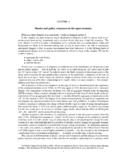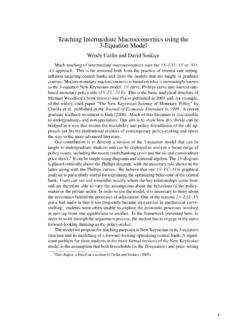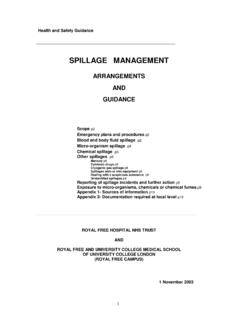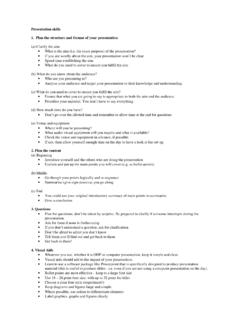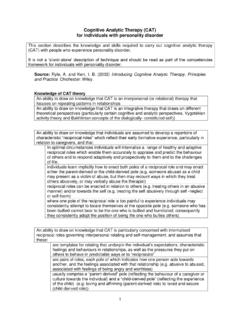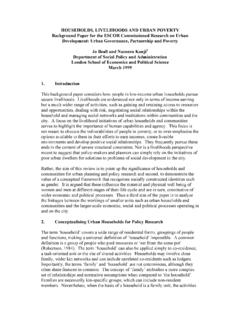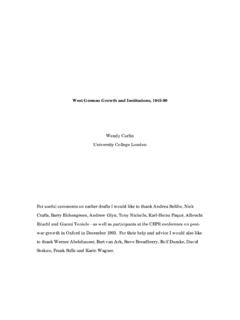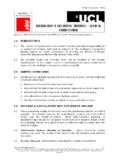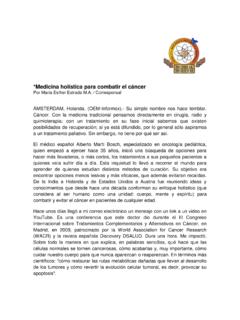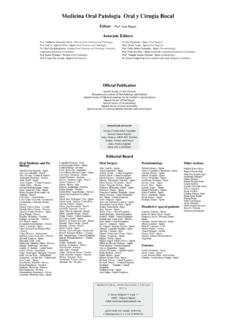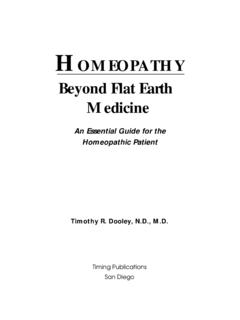Transcription of Archaeological remains as a source of evidence for …
1 Archaeological remains as a source of evidence for Roman Medicine Dr. Patty Baker University of Kent In order to understand Roman medicine most scholars rely on ancient medical texts to understand the Roman views about the functions of the body, the etiology of diseases, surgical procedures and perceptions of health. Yet, Archaeological remains of medical instruments and buildings identified as hospitals also shed light onto past medical practices. In this paper, I will provide general information about what has been said by scholars on the archaeology of medical tools and valetudinaria (hospitals) with comparisons to ancient medical texts. Archaeologists tend to limit themselves to relying on these texts to describe the functions of medical tools and identification of hospitals; yet, by using different Archaeological methods of interpretation it is possible to know more about these objects and structures.
2 In regards to medical tools one can learn about other functions they may have served and what people thought about them. It will also be demonstrated that there may be an over or misinterpretation of buildings identified as hospitals in the Roman army that are based on early twentieth century Archaeological methods of interpretation and expectations of what a hospital should be. This paper is a brief overview of four previous works (Baker 2002a, 2002b, 2004a, 2004b) that explore these questions in more detail. The paper is laid out to first provide a preliminary background to the types of medical tools that survive and what is said about them in the ancient medical texts. Following this is a brief discussion of their other functions and meanings. Once the material culture is explained, a discussion of the arguments for and against the identification of Roman hospitals will be presented.
3 Archaeologists have interpreted medical instruments through reference to the Greek and Roman medical texts as a means of understanding their surgical functions (Braadbaart 1994 a and b; Jackson 1990, 1993, 1994b, 1995, 1996; K nzl 1983, 1996; Milne 1907). First it must be stated that there are very few medical tools from the Hellenic and Hellenistic periods (5th century BC to 1st century BC) so the focus is on Roman medical tools that date from the first to fourth centuries AD. In comparison with the large numbers of personal ornaments and small metal artefacts from Roman contexts, the quantity of medical instruments that survive in the Archaeological record is not great. The majority of instruments that have been found are more common types such as probes, forceps and scalpels. To introduce the reader to the different types of medical tools I will now present descriptions of those that have been found in the Archaeological record.
4 The following descriptions of medical implements are arranged in alphabetical order and are based on those provided by a number of scholars who have written about them ( Bliquez 1981, 1988; Braadbaart 1994b; Jackson 1990, 1994b; K nzl 1983, 1996; Milne 1907). Normally the tools are divided into two groups by scholars: those that are strictly surgical and those that had the dual function of being both surgical and toilet instruments. The Romans made no such categories when discussing the medical instruments and neither shall I because the categories are modern and distort the ancient typologies. Many of the tools placed in the specific categories have both medical and pharmaceutical functions as well as non-medical functions. The list provided is not complete, as other tools are known of in the Archaeological and literary record, but they are rare, and this paper is meant to provide an introductory background to the subject.
5 Furthermore, this section does not take into consideration other objects that were used for healing such as amulets and charms because this aspect has not been studied in much detail in relation to ancient medicine. THE INSTRUMENTS Cauteries (ferrum cadens, kauth/rion, kauth/r). Very few cauteries are known in the Archaeological record because, according to Jackson, few probably would have been purpose made since they were simply a vehicle for transferring heat (1994b: 177-8). Most were probably made of iron as their Latin name suggests and therefore would have corroded, explaining the small numbers in the Archaeological record. They were used for haemostasis and to remove unhealthy tissue or bone. The cauterisation of unhealthy tissue was done to allow for the healthy tissue to remain undamaged whilst the unhealthy area was being treated (Jackson 1994: 178). It could also be used on boils and gangrene (Albucasis 1.)
6 51-52). A special implement was developed for cauterisation of areas that were difficult to reach. A tube was placed over the hot cautery so that the skin of a non-infected area would remain unharmed (Cels. 7. 11). Since there were many shapes and sizes referred to in the written sources it is likely that doctors could have used a variety of instruments, such as double ended probes, double simple probes as well as the spatula from a spatula probe to fit the size and shape of the area in need of treatment (Braadbaart 1994b: 54; K nzl 1983: 25-6; Milne 1907: 116-20). Cupping Vessels (cucurbitula, siku/a, ku/aqoj). Celsus says that there is scarcely any malady in which blood may not be let (2. 10. 1). Cupping Vessel (height 144mm). After Jackson 1990: Fig. 1:1. According to Albucasis the vessels came in different sizes: large, medium and small depending on the specific areas of the body that might have required different shapes and sizes of the vessels (Spink and Lewis 1973: 46).
7 They were also made of various materials. The cupping vessels made of horn had a hole on the top that was used for creating a vacuum effect. Those manufactured in copper alloy were solid and a piece of burning lint was placed inside them to create a vacuum. Milne quotes Oribasius, who says that they could also be made of glass to measure the amount of blood that was removed from the body (1907: 102-3). Oribasius said that sometimes the lips of the vessel were flat and other times concave, (Med. Coll. 7. 16; Milne 1907: 102). These instruments were used for both wet and dry cupping. For wet cupping a knife was used to make a small incision in the skin and then the vessel was placed over it, drawing out the tainted blood or infected matter. Dry cupping was used in the release of bad humours, and was suggested for headache and painful joints (Jackson 1994b: 182-4).
8 Forceps (vulsella, trixolabi/j) This instrument has many functions and basically acts as an extension of the fingers. It could have been used for personal hygiene and depilation. A variety of forceps have been found in the Archaeological record. Most of the simple tweezers were made of a single strip of metal bent in the middle with straight edges or slightly turned-in edges, some of them are cast with finial decorations. Those with smooth jaws were recommended for epilation in granular conjunctivitis (Paul Aeg. 6. 13; Milne 1907: 91). They could also be used in the removal of bone splinters (Jackson 1994b: 174). Forceps made of one strip of metal with toothed edges (length 107mm). After Jackson 1990: Fig. 3:9. Toothed edges with fixation clamps are found on some types of forceps (myzon, vulsella, mu/dion, sarkolabi/j). The teeth were designed to make traction on an object.
9 They were applied to the removal of warts and partial excision of the uvula, or on tumours found on other areas of the body (Celsus de med 7. 30. 2; K nzl 1983: 18-19). Some forceps have jaws that come out at an angle, rather than being placed straight on the end of the forcep handles. These usually have concave jaws on the interior of the instrument and convex jaws on the exterior. Sometimes there are fine teeth at the end of the jaws. Although Paul of Aegina does not provide a separate name for these forceps, it is suggested by Milne that these were the type used when Paul of Aegina was discussing the operation for an eyelid with trichiasis (Paul Aeg. 6. 8). Forceps with edges turned inwards (length 134mm). After Jackson 1990: Fig. 2:3. Dental forceps (forfex, o)donta/gra, r(iza\gra) are designed more specifically for the task of tooth removal. They have powerful jaws sometimes with an indentation for the tooth, so the tooth would not be crushed during removal, which would have caused greater problems.
10 To create a stronger hold on the tooth the arms of the dental forceps were crossed in the centre and attached with a bolt (Jackson 1994: 175-6). Dental forceps (length 180mm). After Matth us 1989: Fig. 13. For the removal of bone and missiles, such as arrow and spearheads, forceps were made with strong arms crossed in the centre and for an even greater grip the head of the forceps had serrated teeth. The removal of the uvula was a common operation in the Roman period, so a specific type of forceps was designed to aid in its removal, called the staphylagra. These could also be used in a haemorrhoidectomy (Jackson 1994a: 168). The staphylagra were made of two arms joined in the centre and the jaws of the instrument were toothed in order to crush the uvula and clamp it down while another set of forceps was employed to twist the uvula off the soft pallet of the throat. Staphylagra (length 192mm).
